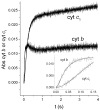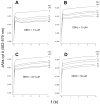The dimeric structure of the cytochrome bc(1) complex prevents center P inhibition by reverse reactions at center N
- PMID: 18454936
- PMCID: PMC2495775
- DOI: 10.1016/j.bbabio.2008.04.008
The dimeric structure of the cytochrome bc(1) complex prevents center P inhibition by reverse reactions at center N
Abstract
Energy transduction in the cytochrome bc(1) complex is achieved by catalyzing opposite oxido-reduction reactions at two different quinone binding sites. We have determined the pre-steady state kinetics of cytochrome b and c(1) reduction at varying quinol/quinone ratios in the isolated yeast bc(1) complex to investigate the mechanisms that minimize inhibition of quinol oxidation at center P by reduction of the b(H) heme through center N. The faster rate of initial cytochrome b reduction as well as its lower sensitivity to quinone concentrations with respect to cytochrome c(1) reduction indicated that the b(H) hemes equilibrated with the quinone pool through center N before significant catalysis at center P occurred. The extent of this initial cytochrome b reduction corresponded to a level of b(H) heme reduction of 33%-55% depending on the quinol/quinone ratio. The extent of initial cytochrome c(1) reduction remained constant as long as the fast electron equilibration through center N reduced no more than 50% of the b(H) hemes. Using kinetic modeling, the resilience of center P catalysis to inhibition caused by partial pre-reduction of the b(H) hemes was explained using kinetics in terms of the dimeric structure of the bc(1) complex which allows electrons to equilibrate between monomers.
Figures







Similar articles
-
Rapid electron transfer between monomers when the cytochrome bc1 complex dimer is reduced through center N.J Biol Chem. 2005 Jun 17;280(24):22732-40. doi: 10.1074/jbc.M413592200. Epub 2005 Apr 15. J Biol Chem. 2005. PMID: 15833742
-
Regulatory interactions in the dimeric cytochrome bc(1) complex: the advantages of being a twin.Biochim Biophys Acta. 2008 Sep;1777(9):1079-91. doi: 10.1016/j.bbabio.2008.04.022. Epub 2008 Apr 22. Biochim Biophys Acta. 2008. PMID: 18471987 Free PMC article. Review.
-
Mutations in cytochrome b that affect kinetics of the electron transfer reactions at center N in the yeast cytochrome bc1 complex.Biochim Biophys Acta. 2008 Mar;1777(3):239-49. doi: 10.1016/j.bbabio.2007.08.005. Epub 2007 Sep 6. Biochim Biophys Acta. 2008. PMID: 18328328
-
Functional flexibility of electron flow between quinol oxidation Qo site of cytochrome bc1 and cytochrome c revealed by combinatory effects of mutations in cytochrome b, iron-sulfur protein and cytochrome c1.Biochim Biophys Acta Bioenerg. 2018 Sep;1859(9):754-761. doi: 10.1016/j.bbabio.2018.04.010. Epub 2018 Apr 27. Biochim Biophys Acta Bioenerg. 2018. PMID: 29705394
-
Domain conformational switch of the iron-sulfur protein in cytochrome bc1 complex is induced by the electron transfer from cytochrome bL to bH.Biochim Biophys Acta. 2008 Jul-Aug;1777(7-8):1038-43. doi: 10.1016/j.bbabio.2008.03.033. Epub 2008 Apr 10. Biochim Biophys Acta. 2008. PMID: 18452702 Review.
Cited by
-
Structure and function of the S. pombe III-IV-cyt c supercomplex.Proc Natl Acad Sci U S A. 2023 Nov 14;120(46):e2307697120. doi: 10.1073/pnas.2307697120. Epub 2023 Nov 8. Proc Natl Acad Sci U S A. 2023. PMID: 37939086 Free PMC article.
-
Effect of calcium on the oxidative phosphorylation cascade in skeletal muscle mitochondria.Biochemistry. 2013 Apr 23;52(16):2793-809. doi: 10.1021/bi3015983. Epub 2013 Apr 11. Biochemistry. 2013. PMID: 23547908 Free PMC article.
-
Computational modeling analysis of mitochondrial superoxide production under varying substrate conditions and upon inhibition of different segments of the electron transport chain.Biochim Biophys Acta. 2015 Jun-Jul;1847(6-7):656-79. doi: 10.1016/j.bbabio.2015.04.005. Epub 2015 Apr 11. Biochim Biophys Acta. 2015. PMID: 25868872 Free PMC article.
-
The Q cycle of cytochrome bc complexes: a structure perspective.Biochim Biophys Acta. 2011 Jul;1807(7):788-802. doi: 10.1016/j.bbabio.2011.02.006. Epub 2011 Feb 23. Biochim Biophys Acta. 2011. PMID: 21352799 Free PMC article. Review.
-
Cryo-EM structure and kinetics reveal electron transfer by 2D diffusion of cytochrome c in the yeast III-IV respiratory supercomplex.Proc Natl Acad Sci U S A. 2021 Mar 16;118(11):e2021157118. doi: 10.1073/pnas.2021157118. Proc Natl Acad Sci U S A. 2021. PMID: 33836592 Free PMC article.
References
-
- Zhang ZL, Huang LS, Shulmeister VM, Chi YI, Kim KK, Hung LW, Crofts AR, Berry EA, Kim SH. Electron transfer by domain movement in cytochrome bc1. Nature. 1998;392:677–684. - PubMed
-
- Yu CA, Xia D, Kim H, Deisenhofer J, Zhang L, Kachurin AM, Yu L. Structural basis of functions of the mitochondrial bc1 complex. Biochim Biophys Acta. 1998;1365:151–158. - PubMed
-
- Iwata S, Lee JW, Okada K, Lee JK, Iwata M, Rasmussen B, Link TA, Ramaswamy S, Jap BK. Complete structure of the 11-subunit bovine mitochondrial cytochrome bc1 complex. Science. 1998;281:64–71. - PubMed
-
- Hunte C, Koepke J, Lange C, Rossmanith T, Michel H. Structure at 2.3 Å resolution of the cytochrome bc1 complex from the yeast Saccharomyces cerevisiae co-crystallized with an antibody Fv fragment. Structure. 2000;8:669–684. - PubMed
-
- Berry EA, Huang LS, Saechao LK, Pon NG, Valkova-Valchanova M, Daldal F. X-Ray Structure of Rhodobacter capsulatus cytochrome bc1: Comparison with its mitochondrial and chloroplast counterparts. Photosynth Res. 2004;81:251–275. - PubMed
MeSH terms
Substances
Grants and funding
LinkOut - more resources
Full Text Sources
Molecular Biology Databases

